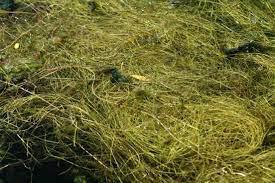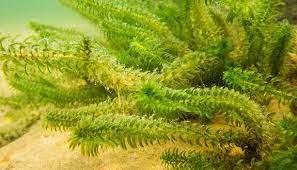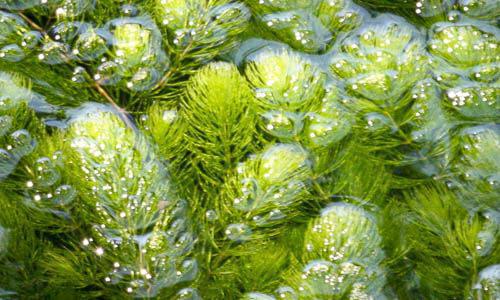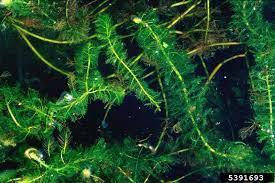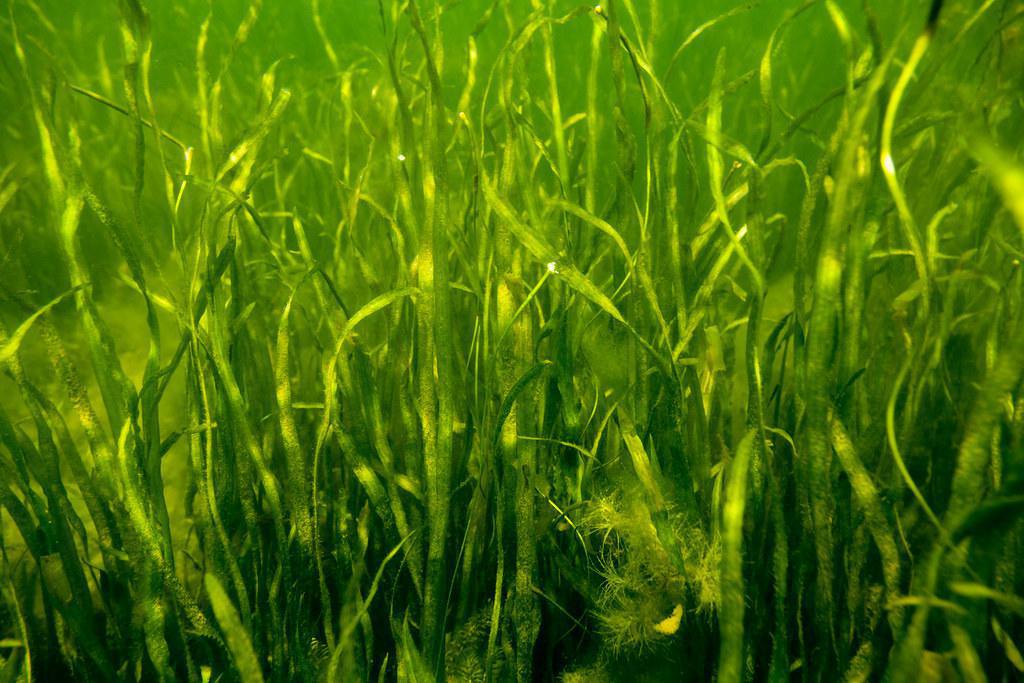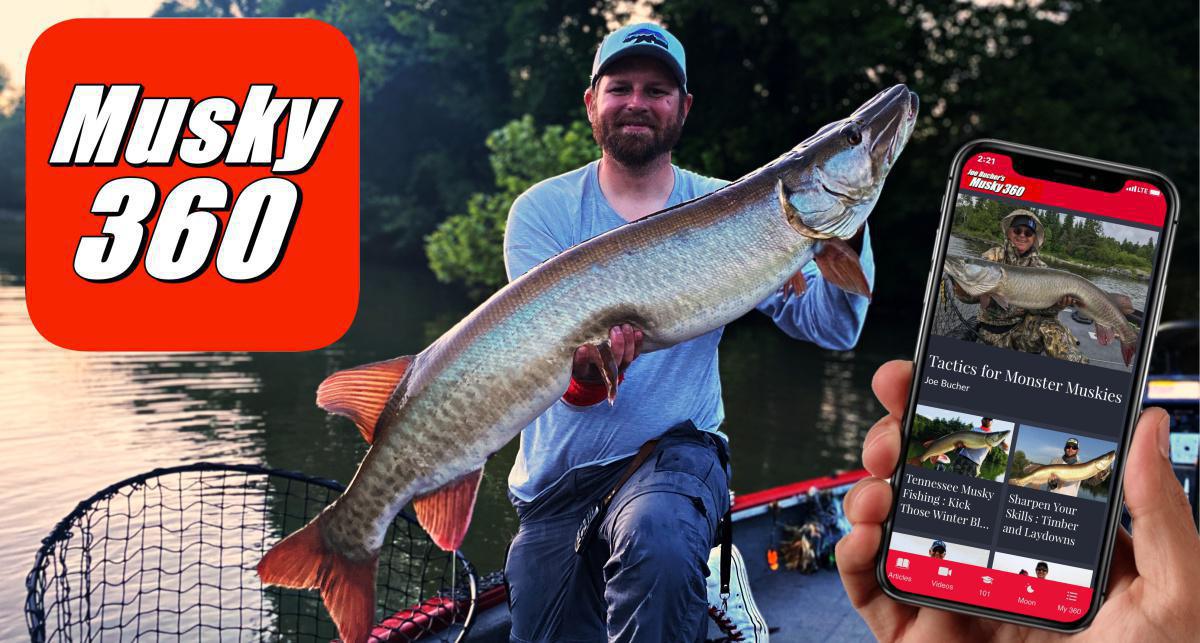Broad-leaf Pondweeds "Cabbage"
Common names: Large-leaf pondweed, claspingleaf (Richardson) pondweed, floating-leaf pondweed, whitestem pondweed, broad-leaf cabbage, musky cabbage, bass weed.
Location: Found in lakes and streams, growing in depths up to 20 feet; often grow near drop-offs.
Description: Leaves 2 to 8 inches long; large-leaf and claspingleaf pondweeds grow below the water surface, except for the flowering stalk; floating-leaf pondweed grows below the water surface, except for their flowering stalk and large, floating leaves; all species have thin and delicate submerged leaves, tough stems that are firmly rooted, and a stiff appearance when out of the water.
How to identify: Leaves alternate along the stem. Often grow in patches or beds; have small seed heads crowded into spikes, often sticking up above water from June through August. Floating-leaf pondweed----Floating leaves are slightly heart-shaped. Large-leaf pondweed----Floating leaves are oval-shaped; submerged leaves are large and wavy; plants are seldom branched. Claspingleaf pondweed----Leaves are wide and wavy with a broad base that clasps the stem; plant often branches toward tip; often confused with curlyleaf pondweed, which has small "teeth" along leaf edges (see page 31), but claspingleaf pondweed has no "teeth" on leaf edges.
Bushy Pondweeds and Naiads
Common names: Bushy naiad,(pronounced NAY-ads) water naiad, brittle naiad, slender naiad, spiny leaf naiad.
Location: Clear water at depths of up to 20 feet.
Description: Grow entirely below water surface; have long, waving stems in deep water and are dense and bushy in shallow water. These are annual plants which must start from seed each year.
How to identify: Leaves are tapered to a fine point with tiny "spines"; seeds are shiny and smooth. Bushy pondweed is sometimes confused with chara, but chara has a musky odor when crushed and bushy pondweed does not.
Canada Waterweed (Elodea canadensis)
Common names: Elodea (pronounced el-oh-DEE-a), American elodea, common elodea, anacharis, Canada waterweed.
Location: Found in lakes in depths up to 10 feet, often in hard water, and near stream inlets.
Description: Grows entirely underwater, except for a small white flower that blooms during the summer; has branched stems; plants and leaves are usually a dark, grass-green color; leaves are oval-shaped and arranged in clusters of three or four around the stem.
How to identify: Look for leaf clusters compacted near the tip and spaced farther apart down the stem; stems are brittle, branched, and form a large mass near the lake bottom; white flowers have three to four petals and bloom during the summer; flowers are attached to the stem by a threadlike stalk.
CoontaiI
Description: Grows underwater with no roots; upper leaves may reach the surface; central hollow stem has stiff, dark-green leaves; plants may be long and sparse, but are often bushy near the tip, giving the plant a "coontail" or "Christmas tree" appearance.
How to identify: Often confused with watermilfoil, but coontail leaves are spiny and forked rather than feather-like.
Eurasian Watermilfoil
Appearance
Eurasian watermilfoil is a rooted, submerged aquatic plant. The leaves appear green while the stems are white to reddish.
Leaves and Stem
Leaves are feather-like, with four leaves arranged in a whorl (radiating out from a single point) around the stem. Space between whorls along the stem can be a half inch or greater. Each leaf has a central axis with 12 to 21 leaflet pairs. Leaflets are limp when the plant is removed from the water. The stem is typically light brown, but sometimes pink. Tips of the plant are sometimes red or pink in color. Color alone should not be used for identification as it can be highly variable.
Narrow-leaf Pondweeds
Common names: Flat-stemmed, leafy, and sago pondweeds.
Location: Grow below water surface; are firmly rooted; have branched, slender stems; have grasslike, narrow leaves; may have flowers or seeds extending above water surface; are limp when out of the water.
How to identify: Most narrow-leaf pondweeds have no floating leaves----it is only the seeds of some types that reach or extend above the surface. Sago pondweed has stiff, threadlike leaves that appear bushy and are alternately arranged on one stem; spreading leaves in the water resemble a fan; small, pebble-sized fruits are spaced on the stem and emerge from the water.
Eel Grass
Common names: Water celery, eelgrass, tapegrass.
Location: Lakes in depths up to 15 feet and streams; prefers semi-hard bottom such as sand covered with a thin layer of muck.
Description: Leaves are ribbon-like, dark-green, and grow below the water surface; rooted in mud; in late summer, produces a small, whitish-yellow flower, supported by a coiled stalk; often grows in beds amid pondweeds and other submerged plants.
How to identify: Unbranched leaves extending from the lake bottom to the water surface; flowers (and occasionally some leaves) float on the surface; leaves are attached to a horizontal central stem right above lake bottom.


